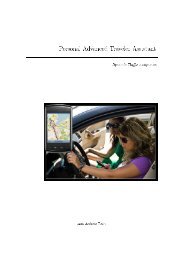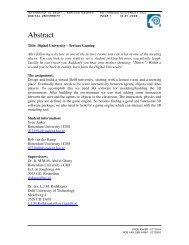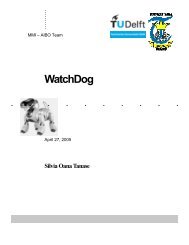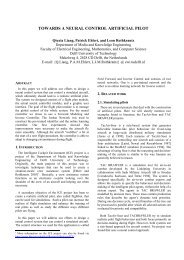Recognition of facial expressions - Knowledge Based Systems ...
Recognition of facial expressions - Knowledge Based Systems ...
Recognition of facial expressions - Knowledge Based Systems ...
You also want an ePaper? Increase the reach of your titles
YUMPU automatically turns print PDFs into web optimized ePapers that Google loves.
numeric information. Usually, a neuron is set to handle values within a given interval, i.e.<br />
[-0.5, +0.5] or [0, 1]. Since there is a limitation in representing numeric values, any other<br />
value that is outside the interval can be mapped to a value in the interval (Figure 10).<br />
Figure 10. Mapping any value so as to be encoded by a single neuron<br />
In this case <strong>of</strong> encoding, the previous process <strong>of</strong> discretization applied on the value <strong>of</strong> the<br />
model parameters is no longer necessary. Every neural unit can manage to keep any value<br />
<strong>of</strong> one parameter without any other intervention. By using a single neuron for encoding<br />
the value <strong>of</strong> a parameter, the structure <strong>of</strong> the ANN becomes simpler and the<br />
computational effort is less. The network’s structure is as presented below:<br />
In the case the network is used for recognizing the presence <strong>of</strong> Action Units, the output<br />
layer would require 22 neurons, one for each AU. Moreover, in the case the ANN would<br />
be assumed to recognize <strong>facial</strong> <strong>expressions</strong>, the output layer would consist only <strong>of</strong> few<br />
bits, enough for encoding an index to be associated to one <strong>of</strong> the six different basic <strong>facial</strong><br />
<strong>expressions</strong>.<br />
The second method <strong>of</strong> encoding parameter value in an ANN is to use discretization<br />
mechanism before and to encode any value by using a small group <strong>of</strong> neurons.<br />
For a set <strong>of</strong> 10 parameters, each parameter is encoded as a group <strong>of</strong> three neurons that is<br />
able to encode a value big enough to represent the maximum number <strong>of</strong> the classes for<br />
each discrete parameter. The experiments conducted required a number <strong>of</strong> 5 or 7 distinct<br />
values per parameter. The second layer is that <strong>of</strong> the hidden neurons. For the experiments<br />
- 46 -
















